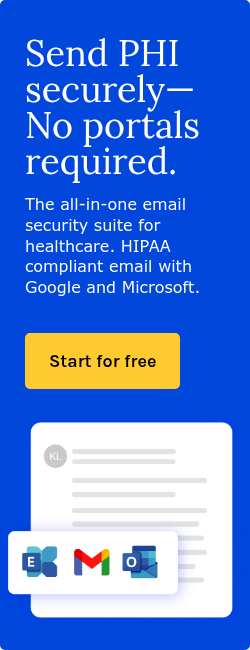5 min read
What healthcare providers should know about the AI Bill of Rights Blueprint
Caitlin Anthoney May 06, 2025

“Among the great challenges posed to democracy today is the use of technology, data, and automated systems in ways that threaten the rights of the American public,” explains the White House's Blueprint for an AI Bill of Rights (2022)
“Too often, these tools are used to limit our opportunities and prevent our access to critical resources or services. These problems are well documented. In America and around the world, systems supposed to help with patient care have proven unsafe, ineffective, or biased.”
Hence, the Blueprint addresses the democratic challenges associated with artificial intelligence (AI), automated systems, and mass data collection.
More specifically, it suggests five guiding principles for protecting the public:
- Safe and effective systems.
- Algorithmic discrimination protections.
- Data privacy.
- Notice and explanation.
- Human alternatives, consideration, and fallback.
In healthcare, using HIPAA compliant email aligns directly with the Blueprint's ethical and technical standards.
How HIPAA compliant email upholds this Blueprint
Safe and effective systems
According to the Blueprint’s first principle, healthcare systems must undergo pre-deployment testing, risk mitigation, and ongoing monitoring to “proactively protect you from harms stemming from unintended, yet foreseeable, uses or impacts of automated systems.”
Using standardized email, for example, can lead to breaches of patients’ protected health information (PHI), compromising their trust and exposing organizations to legal and financial risk.
HIPAA compliant email platforms, like Paubox, use advanced encryption, access controls, and audit trails to minimize these risks.
Therefore, implementing secure email systems that have been rigorously tested and monitored helps healthcare providers uphold the Blueprint’s first principle, preventing harm before it occurs.
Algorithmic discrimination protections
“Algorithmic discrimination occurs when automated systems contribute to unjustified different treatment or impacts disfavoring people based on their race, color, ethnicity, sex (including pregnancy, childbirth, and related medical conditions, gender identity, intersex status, and sexual orientation), religion, age, national origin, disability, veteran status, genetic information, or any other classification protected by law,” the Blueprint explains.
In healthcare, bias can occur through clinical algorithms and how and when patients receive information.
To address this bias, healthcare providers must ensure “fair and just opportunities for optimal health outcomes [promote] universal safeguards for patient safety,” as evidenced by the AI in Medicine article on Addressing AI Algorithmic Bias in Health Care.
Given the ubiquity of HIPAA compliant emails, providers can use simple language and user-friendly interfaces to promote equitable healthcare, where patients can receive their care instructions and medication updates or request follow-ups straight from their inboxes.
Ultimately, giving patients from different socio-economic backgrounds direct access to their health information while upholding their civil rights.
Data privacy
According to this principle, “Designers, developers, and deployers of automated systems should seek your permission and respect your decisions regarding collection, use, access, transfer, and deletion of your data in appropriate ways and to the greatest extent possible; where not possible, alternative privacy by design safeguards should be used.”
This principle directly addresses data privacy, intersecting with HIPAA’s Rules for safeguarding individuals’ PHI. Patients have the right to know what data is collected, how it’s used, and with whom it’s shared.
Since email is the most vulnerable attack vector for healthcare breaches, HIPAA compliant platforms must be “built around the legal and ethical imperatives of data minimization, informed consent, and breach prevention.”
As the Blueprint notes, privacy should be protected “through built-in safeguards and transparency.” Paubox, for example, automatically encrypts all outgoing emails without requiring patients to manage inconvenient login portals.
Notice and explanation
The fourth principle of the Blueprint centers on clear communication so people know how decisions are made and how systems work.
It states, “Designers, developers, and deployers of automated systems should provide generally accessible plain language documentation including clear descriptions of the overall system functioning and the role automation plays, notice that such systems are in use, the individual or organization responsible for the system, and explanations of outcomes that are clear, timely, and accessible.”
HIPAA compliant email can contribute to this transparency through accessible communication with clear notices of privacy practices, consent forms, and care plans. These systems also allow for digital audit trails that can be referenced in disputes or misunderstandings.
According to a PEC Innovation article on patients' perspectives on digital health tools, “Patient empowerment, self-management, and personalization drove adoption of digital health tools.”
Moreover, patients are more likely to trust secure health communications when platforms explain privacy safeguards and data usage. Ultimately, the shared information helps patients understand the content and the context of their care for better decision-making and health outcomes.
Human alternatives, consideration, and fallback
Finally, the Blueprint insists that people should have access to a human alternative when using automated systems, upholding the right to agency and redress.
“In some cases, a human or other alternative may be required by law. You should have access to timely human consideration and remedy by a fallback and escalation process if an automated system fails, it produces an error, or you would like to appeal or contest its impacts on you,” the White House explains.
Personalized HIPAA compliant emails allow healthcare providers to enhance patient-centered care. Providers can communicate directly with patients, answer questions, and document consent rather than relying on an automated system that replaces human interaction.
The goal is not automation for automation’s sake, but personalized digital support that improves patient outcomes.
Related: Why personalized healthcare emails are better
How HIPAA compliant email advances civil rights in healthcare
The White House’s Blueprint for an AI Bill of Rights mandates using ethical platforms that uphold individual agency, transparency, and non-discrimination. Secure communication platforms like HIPAA compliant email systems can operationalize these rights in everyday healthcare interactions, preventing discrimination, expanding access, and promoting transparency for marginalized patients.
Privacy as a civil right
Secure emails protect a patient’s right to confidentiality, especially for communities historically targeted or discriminated against, like LGBTQ+ patients, people living with HIV, or undocumented individuals.
These emails safeguard their health information and allow these patients to receive health updates without risking potential exposure.
Equitable access to health information
Patients must be able to access their health information regardless of race, language, income, or digital literacy. HIPAA compliant email promotes equity, supporting plain-language communication, mobile optimization, and intuitive design.
Solutions like Paubox deliver secure messages directly to a patient’s inbox. It also gives those in remote locations convenient access to their information, helping them overcome potential barriers like travel time or transportation costs.
Supporting informed consent and autonomy
According to JAMA Network’s Guiding Principles to Address the Impact of Algorithm Bias on Racial and Ethnic Disparities in Health and Health Care, promoting equity requires addressing bias “during all phases of the health care algorithm life cycle.” Communication is part of that lifecycle. When patients understand how their data is used and can opt into care pathways with full knowledge, their civil rights are protected.
Civil rights in healthcare include the right to make informed decisions. HIPAA compliant email supports this, allowing providers to share consent forms, treatment plans, and privacy notices in accessible formats. Patients can read, ask questions, and reply on their own terms, promoting autonomy and transparency.
Keeping the human element
Even as automation becomes more prevalent, HIPAA compliant email keeps the human touch intact. It enables direct communication between patients and providers, something no chatbot or algorithm can replicate. The ability to contact a person, ask questions, and receive clear, confidential answers upholds the right to redress and fairness.
For example, a hospital can use a HIPAA compliant email to securely inform a patient about an abnormal test result. Instead of just sharing the data, the email invites the patient to schedule a consultation with their doctor, offering a secure link or phone number to connect.
It protects patient privacy while allowing them to speak with a real person, ask questions, and understand their care. It also avoids impersonal, automated pathways and reinforces dignity, trust, and transparency, upholding civil rights and ethical healthcare.
Go deeper: How automated HIPAA compliant emails can increase patient satisfaction
FAQs
Can providers use regular email services for HIPAA compliant emails?
No, regular email services like Gmail, Yahoo, or Outlook are not HIPAA compliant as they lack the necessary encryption, audit trails, and automatic safeguards that protect individuals’ protected health information (PHI).
Healthcare providers must use a HIPAA compliant solution, like Paubox, which automatically encrypts emails during transmission and at rest, preventing potential data breaches.
Is patient consent required for email communication?
Yes, HIPAA regulations mandate that healthcare providers obtain the patient’s explicit consent before using email to communicate PHI. They must inform patients of the risks associated with electronic communication and obtain documented permission.
Providers should also give patients the option to opt-out or choose alternative secure communication methods.
See also: A HIPAA consent form template that's easy to share
Are personalized emails compliant with patient privacy regulations?
Yes, personalized emails can comply with HIPAA regulations, but only if sent through a secure email platform. Paubox allows providers to tailor messages with patient-specific details, like appointment reminders, treatment plans, or lab results, while still protecting PHI through advanced encryption, access controls, and other built-in privacy protections.
Subscribe to Paubox Weekly
Every Friday we'll bring you the most important news from Paubox. Our aim is to make you smarter, faster.




